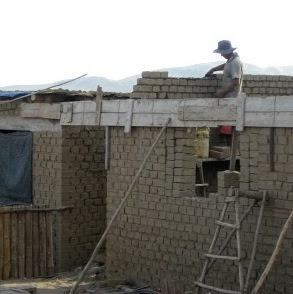Every time I open a box and see the hand knits that the mothers in Peru are creating, I am humbled by knowing the conditions they are living in and reminded of why we are doing this.
Here's a bit of history.
Over the last twenty years Peru has gone through some major cultural changes. Ten years removed from communism the country is still struggling to pull its people out of severe poverty. Jobs are being created but not quick enough.
One of the organizations at work down there is
While I was there, one of the best days of my trip was to go into one of the barrios with two of the organizations directors.
These photos are ones I took while in Trujillo, Peru.
In Peru, a barrio is referred to as a district or community of people that are living on top of landfill areas in the outskirts of the cities.
How the barrio system works is sad yet hopeful.
The city is ever expanding from the center out. If you draw imaginary concentric circles around the city's core you eventually come upon a 7th, 6th, 5th, generation barrio, all the way to the outskirts which would be considered the 1st.
These are pictures of a first generation barrio
These are pictures of a first generation barrio
The family, usually abandoned or widowed women and children have come out of the Andes mountains in hopes of finding work in the city.
An informal a system had been set up where a small (approx 15'x15') plot of land is assigned to them.
The concept is like homesteading, you develop your home and you get to stay.
The houses, estera huts are created out of anything found; straw matting, cardboard, plastic, twin and reed.
Eventually they begin adding adobe brick, maybe a found window, a plywood door and a small plant out front to beautify their home.
Over time the homes begin to grow into each other. Businesses are created by entrepreneurial spirits and a community is formed.
During the first year, the government drives by with a water truck once a week and families collect water in whatever they have gleaned.
The second year, a community water station is built.
Third year, electricity is dropped in and a few main roads are paved.
Third year, electricity is dropped in and a few main roads are paved.
Fourth fifth, and sixth years more roads are paved, trees planted and a park is created.
The barrio has now begun to blend the boundary's and has become a part of the ever growing city.
The people that I met were wonderful.
Cheerful, hopeful, and beautiful.
They proudly shared their homes and posed for photos.
Kids were as kids are, giggly, playful and happy.
Kids were as kids are, giggly, playful and happy.
It is these mothers that are creating the hand knit alpaca throws, sweaters, wraps, etc. that we are featuring, This is creating a sustainable income for them and their families.
Seeing all these photos again, just reinforces how much I want to go back!

















No comments:
Post a Comment